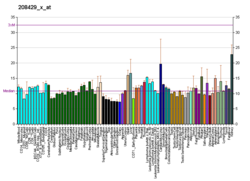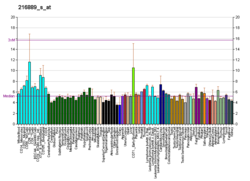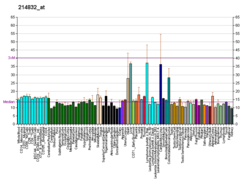HNF4A
HNF4AまたはHNF4α(hepatocyte nuclear factor 4 alpha)、NR2A1(nuclear receptor subfamily 2, group A, member 1)は、ヒトではHNF4A遺伝子にコードされる核内受容体である[5][6]。
機能[編集]
HNF4αはホモ二量体としてDNAに結合する転写因子であり、肝臓遺伝子の発現を調節する転写因子であるHNF1αなど、いくつかの遺伝子の発現を制御する。HNF4αは肝臓、腎臓、腸の発生に関与している。HNF4A遺伝子からは選択的スプライシングにより、複数の転写バリアントが生じる[7]。
HNF4AはPXRとCARを介したCYP3A4の転写活性化に必要である[8]。HNF4A遺伝子の変異は、CYP2D6などHNF4αの下流のタンパク質の活性に影響を与える[9][10]。
アルカロイドの1種であるベルベリンは、HNF4Aの発現をアップレギュレーションする。
臨床的意義[編集]
HNF4A遺伝子の変異は、若年発症成人型糖尿病(MODY)[11]、特にMODY 1と関係している。少なくとも56種類の疾患原因変異がこの遺伝子には発見されている[12]。
HNF4A遺伝子のミスセンス変異は、ファンコーニ症候群の表現型の出現とも関係している[14]。
相互作用[編集]
HNF4αは次に挙げる因子と相互作用することが示されている。
出典[編集]
- ^ a b c GRCh38: Ensembl release 89: ENSG00000101076 - Ensembl, May 2017
- ^ a b c GRCm38: Ensembl release 89: ENSMUSG00000017950 - Ensembl, May 2017
- ^ Human PubMed Reference:
- ^ Mouse PubMed Reference:
- ^ “Cloning and sequencing of cDNAs encoding the human hepatocyte nuclear factor 4 indicate the presence of two isoforms in human liver”. Gene 147 (2): 269–72. (Sep 1994). doi:10.1016/0378-1119(94)90079-5. PMID 7926813.
- ^ “Human hepatocyte nuclear factor-4 (hHNF-4) gene maps to 20q12-q13.1 between PLCG1 and D20S17”. Human Genetics 99 (2): 233–6. (Feb 1997). doi:10.1007/s004390050345. PMID 9048927.
- ^ “Entrez Gene: HNF4A hepatocyte nuclear factor 4, alpha”. 2023年6月7日閲覧。
- ^ “The orphan nuclear receptor HNF4alpha determines PXR- and CAR-mediated xenobiotic induction of CYP3A4”. Nature Medicine 9 (2): 220–4. (Feb 2003). doi:10.1038/nm815. PMID 12514743.
- ^ “Genetic polymorphism of hepatocyte nuclear factor-4alpha influences human cytochrome P450 2D6 activity”. Hepatology 48 (2): 635–45. (2008). doi:10.1002/hep.22396. PMID 18666237.
- ^ “Effect of HNF4α genetic polymorphism G60D on the pharmacokinetics of CYP2D6 substrate tolterodine in healthy Korean individuals”. Pharmacogenetics and Genomics 23 (3): 175–9. (2013). doi:10.1097/FPC.0b013e32835de25e. PMID 23292115.
- ^ “Roles of HNF1α and HNF4α in pancreatic β-cells: lessons from a monogenic form of diabetes (MODY)”. Vitamins and Hormones 95: 407–23. (2014). doi:10.1016/B978-0-12-800174-5.00016-8. PMID 24559927.
- ^ “Refinement of evolutionary medicine predictions based on clinical evidence for the manifestations of Mendelian diseases”. Scientific Reports 9 (1): 18577. (December 2019). Bibcode: 2019NatSR...918577S. doi:10.1038/s41598-019-54976-4. PMC 6901466. PMID 31819097.
- ^ “Proteogenomic characterization of human colon and rectal cancer”. Nature 513 (7518): 382–7. (2014). Bibcode: 2014Natur.513..382.. doi:10.1038/nature13438. PMC 4249766. PMID 25043054.
- ^ “Proximal renal tubular acidosis with and without Fanconi syndrome”. Kidney Research and Clinical Practice 38 (3): 267–281. (September 2019). doi:10.23876/j.krcp.19.056. PMC 6727890. PMID 31474092.
- ^ “Functional localization and competition between the androgen receptor and T-cell factor for nuclear beta-catenin: a means for inhibition of the Tcf signaling axis”. Oncogene 22 (36): 5602–13. (Aug 2003). doi:10.1038/sj.onc.1206802. PMID 12944908.
- ^ “Functional association between CBP and HNF4 in trans-activation”. Biochemical and Biophysical Research Communications 241 (3): 664–9. (Dec 1997). doi:10.1006/bbrc.1997.7871. PMID 9434765.
- ^ “CREB-binding protein is a transcriptional coactivator for hepatocyte nuclear factor-4 and enhances apolipoprotein gene expression”. The Journal of Biological Chemistry 274 (13): 9013–21. (Mar 1999). doi:10.1074/jbc.274.13.9013. PMID 10085149.
- ^ a b “Polyamines modulate the interaction between nuclear receptors and vitamin D receptor-interacting protein 205”. Molecular Endocrinology 16 (7): 1502–10. (Jul 2002). doi:10.1210/mend.16.7.0883. PMID 12089346.
- ^ a b “TRAP/SMCC/mediator-dependent transcriptional activation from DNA and chromatin templates by orphan nuclear receptor hepatocyte nuclear factor 4”. Molecular and Cellular Biology 22 (15): 5626–37. (Aug 2002). doi:10.1128/MCB.22.15.5626-5637.2002. PMC 133960. PMID 12101254.
- ^ “The orphan nuclear receptor SHP inhibits hepatocyte nuclear factor 4 and retinoid X receptor transactivation: two mechanisms for repression”. Molecular and Cellular Biology 20 (1): 187–95. (Jan 2000). doi:10.1128/MCB.20.1.187-195.2000. PMC 85074. PMID 10594021.
- ^ “Suppression of hepatitis B virus core promoter by the nuclear orphan receptor TR4”. The Journal of Biological Chemistry 278 (11): 9353–60. (Mar 2003). doi:10.1074/jbc.M205944200. PMID 12522137.
関連文献[編集]
- “Monogenic diabetes mellitus in youth. The MODY syndromes”. Endocrinology and Metabolism Clinics of North America 28 (4): 765–85. (Dec 1999). doi:10.1016/S0889-8529(05)70101-8. PMID 10609119.
- “Transcriptional regulation of the human apolipoprotein genes”. Frontiers in Bioscience 6: D456-504. (Mar 2001). doi:10.2741/Zannis. PMID 11229886.
- “HNF-4alpha: from MODY to late-onset type 2 diabetes”. Trends in Molecular Medicine 10 (11): 521–4. (Nov 2004). doi:10.1016/j.molmed.2004.09.004. PMID 15519277.
- “The role of HNF4A variants in the risk of type 2 diabetes”. Current Diabetes Reports 5 (2): 149–56. (Apr 2005). doi:10.1007/s11892-005-0043-y. PMID 15794920.
- “HNF4A genetic variants: role in diabetes”. Current Opinion in Clinical Nutrition and Metabolic Care 10 (4): 397–402. (Jul 2007). doi:10.1097/MCO.0b013e3281e3888d. PMID 17563455.
- “Gene for non-insulin-dependent diabetes mellitus (maturity-onset diabetes of the young subtype) is linked to DNA polymorphism on human chromosome 20q”. Proceedings of the National Academy of Sciences of the United States of America 88 (4): 1484–8. (Feb 1991). Bibcode: 1991PNAS...88.1484B. doi:10.1073/pnas.88.4.1484. PMC 51043. PMID 1899928.
- “Recruitment of hepatocyte nuclear factor 4 into specific intranuclear compartments depends on tyrosine phosphorylation that affects its DNA-binding and transactivation potential”. Proceedings of the National Academy of Sciences of the United States of America 92 (21): 9876–80. (Oct 1995). Bibcode: 1995PNAS...92.9876K. doi:10.1073/pnas.92.21.9876. PMC 40905. PMID 7568236.
- “Intestinal apolipoprotein AI gene transcription is regulated by multiple distinct DNA elements and is synergistically activated by the orphan nuclear receptor, hepatocyte nuclear factor 4”. The Journal of Clinical Investigation 96 (1): 528–38. (Jul 1995). doi:10.1172/JCI118065. PMC 185227. PMID 7615825.
- “Exclusive homodimerization of the orphan receptor hepatocyte nuclear factor 4 defines a new subclass of nuclear receptors”. Molecular and Cellular Biology 15 (9): 5131–43. (Sep 1995). doi:10.1128/mcb.15.9.5131. PMC 230760. PMID 7651430.
- “Cloning and sequencing of cDNAs encoding the human hepatocyte nuclear factor 4 indicate the presence of two isoforms in human liver”. Gene 147 (2): 269–72. (Sep 1994). doi:10.1016/0378-1119(94)90079-5. PMID 7926813.
- “Human hepatocyte nuclear factor 4 isoforms are encoded by distinct and differentially expressed genes”. Molecular and Cellular Biology 16 (3): 925–31. (Mar 1996). doi:10.1128/mcb.16.3.925. PMC 231074. PMID 8622695.
- “Mutations in the hepatocyte nuclear factor-4alpha gene in maturity-onset diabetes of the young (MODY1)”. Nature 384 (6608): 458–60. (Dec 1996). Bibcode: 1996Natur.384..458Y. doi:10.1038/384458a0. hdl:2027.42/62605. PMID 8945471.
- “Isolation and characterization of a third isoform of human hepatocyte nuclear factor 4”. Gene 173 (2): 275–80. (Sep 1996). doi:10.1016/0378-1119(96)00183-7. PMID 8964514.
- “Human hepatocyte nuclear factor-4 (hHNF-4) gene maps to 20q12-q13.1 between PLCG1 and D20S17”. Human Genetics 99 (2): 233–6. (Feb 1997). doi:10.1007/s004390050345. PMID 9048927.
- “Differential interaction of nuclear receptors with the putative human transcriptional coactivator hTIF1”. The Journal of Biological Chemistry 272 (18): 12062–8. (May 1997). doi:10.1074/jbc.272.18.12062. PMID 9115274.
- “A missense mutation in the hepatocyte nuclear factor 4 alpha gene in a UK pedigree with maturity-onset diabetes of the young”. Diabetologia 40 (7): 859–62. (Jul 1997). doi:10.1007/s001250050760. PMID 9243109.
- “Studies of the genetic variability of the coding region of the hepatocyte nuclear factor-4alpha in Caucasians with maturity onset NIDDM”. Diabetologia 40 (8): 980–3. (Aug 1997). doi:10.1007/s001250050778. PMID 9267996.
- “Hepatic function in a family with a nonsense mutation (R154X) in the hepatocyte nuclear factor-4alpha/MODY1 gene”. The Journal of Clinical Investigation 100 (6): 1400–5. (Sep 1997). doi:10.1172/JCI119660. PMC 508318. PMID 9294105.
- “Organization and partial sequence of the hepatocyte nuclear factor-4 alpha/MODY1 gene and identification of a missense mutation, R127W, in a Japanese family with MODY”. Diabetes 46 (10): 1652–7. (Oct 1997). doi:10.2337/diabetes.46.10.1652. PMID 9313765.
- “The maturity-onset diabetes of the young (MODY1) transcription factor HNF4alpha regulates expression of genes required for glucose transport and metabolism”. Proceedings of the National Academy of Sciences of the United States of America 94 (24): 13209–14. (Nov 1997). Bibcode: 1997PNAS...9413209S. doi:10.1073/pnas.94.24.13209. PMC 24288. PMID 9371825.








